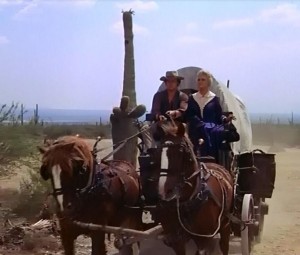Journey To The Promised Land
Ever wonder what route that John and Annalee Cannon would have traveled to get to their destination at the High Chaparral in 1870? With the migration to go west after the Civil War, people had to choose the best trail to get to their destination, and the best time of the year to travel on it.
The Southern routes could be more accessible for a longer time in the winter months to avoid snow and inclimate weather. For example, they could have chosen leaving Fort Smith Arkansas, traveling through Oklahoma territory across the top of Texas near the Canadian River, over to Santa Fe New Mexico, down through Albuquerque to the Apache Pass, then on into Tucson.
The wagons used had to be of the utmost construction, usually named Conestoga or covered wagons, but were also known as Prairie Schooners. Aptly named for the white canvas covers of the wagons crossing the prairies that would remind writers of the sails of a ship at sea. Normally they would be pulled by 2 or more pairs of oxen. Is it any wonder that today we can still see the ruts left behind that were created by these huge heavy vehicles? Often, when the terrain would allow, the wagons would fan out and travel abreast to minimize the dust from each wagon. Then at night they would form a circle or square for shelter from the wind, weather, or just to corral the animals in the center. This was done to prevent them from running away or being stolen by Native Americans. Although horses were something that Indians might attempt to raid, it is said that they rarely attacked a train.
After the Union-Central Pacific railway line in May of 1869 was completed, the wagon trains and caravans decreased in size; however freighting and stagecoach lines became more common. By the 1880’s the decimation of the buffalo herds, the military defeat and relocation of the Rocky Mountain and Great Plains Indians, along with additional construction of railways, decreased the size of these wagon trains.
Leave a Reply